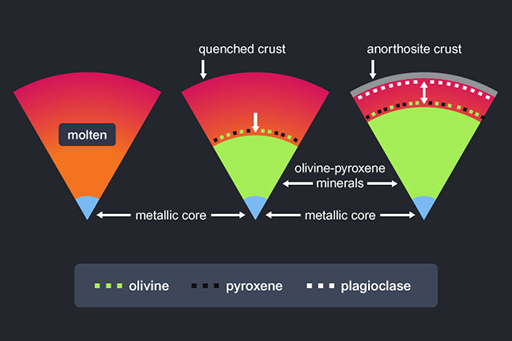1.1 An ocean of magma
In Week 1 you learned that the giant impact hypothesis is the most commonly accepted model for the formation of our Moon (although there are challenges). The impact of a body about the size of Mars into the Earth soon after the formation of the Solar System ejected melted and vaporised material into orbit, which accreted to form small bodies. These smaller bodies gradually combined to form our Moon. The hypothesis predicts that huge amounts of heat generated by this accretion process resulted in the whole surface of the Moon becoming molten at one time and forming one enormous magma ocean (the ‘melt’ referred to below) on the young Moon.

In this scenario, iron and nickel quickly separated from the melt and sank to form a small dense metallic core (left-hand image) and a temporary crust formed on the surface as a result of quenching, i.e. rapid surface cooling (middle image). In time, the magma ocean cooled and minerals began to crystallise. During this process, which probably happened over millions of years, dense minerals sank in the magma ocean and less dense minerals floated upwards to grow a chemically-distinct crust. This density differentiation produced a core, mantle and crust of different compositions: the core (iron rich), the mantle (olivine and pyroxene minerals) and the crust (plagioclase feldspars such as anorthosite – right-hand image). This geochemical and physical process that results in mineral separation is known as fractional crystallisation. The same process occurs on Earth in large magma chambers (located within the crust) and beneath the mid-ocean ridges.
Evidence to support this hypothesis for the formation of the structure of the Moon has come from rocks brought back to Earth by Apollo astronauts and from lunar orbiting spacecraft – for example, the Japanese SELENE mission.
